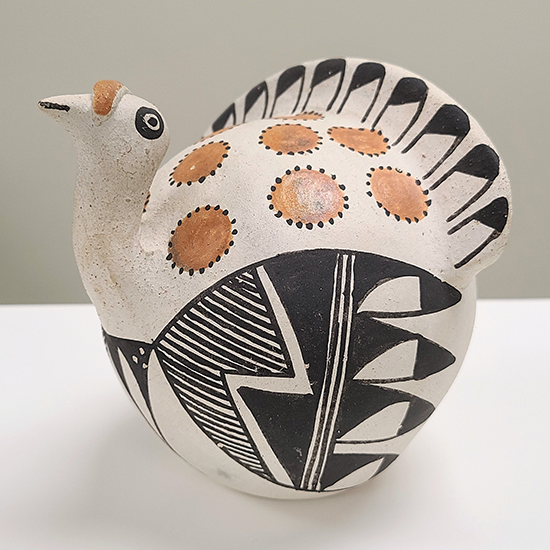Acoma Ceramic Turkey

This ceramic turkey figure is from Acoma Pueblo in New Mexico, which is recognized as the oldest continuously inhabited settlement in North America. The old Pueblo is called Sky City because of its location atop a sheer-walled 367-foot mesa. Today, only about 50 people live in the interconnected adobe buildings that make up Sky City full-time, but it serves as an important spiritual and ceremonial center. More than 5000 tribal members live across several other villages that make up the Acoma reservation.
Acoma pottery is part of a tradition dating back more than a thousand years. Originally, the pottery was functional, providing vessels for cooking, eating, and storage. The modern importance of Pueblo ceramics dates to the mid-19th century, when increased opportunities for trade sparked a revival in traditional art forms. Pottery sales continue to play an important role in the Acoma economy today.
Acoma pottery is widely acclaimed for its beauty and craftsmanship. Potters use a grey clay found in the hills surrounding the Pueblo. This clay allows potters to form very thin walls, one of the characteristics that makes Acoma pottery highly sought after. While some potters still use traditional hand-coiling methods, others have transitioned to using molds to create their pieces. Once fired, potters use brushes made from yucca fibers to paint their creations. Geometric designs with fine black lines are common. As seen on this piece, orange and black are traditional colors.
While figures like this one are not traditional, feather designs are common across many forms. Birds and feathers are associated with prayers for rain and fertility. Turkey figures in particular are made by many Acoma artists. This piece dates to the mid-20th century and is marked only as “Acoma, N.M.” with no artist’s name. This is not uncommon, as most Pueblo pottery prior to the 1960s is unsigned.
